 A A |
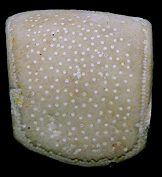 B B |
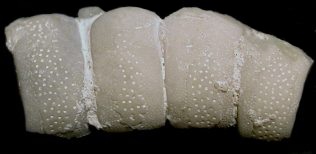 C C |
|
Metopaster parkinsoni (Forbes) |
One of the most common Chalk starfish, occurring in all but last (Portsdown, Rowe) Formations of the Chalk Group. This species also comprises the majority of articulated specimens, particularly from the Seaford Chalk of Southern England. The form is quite variable, but individuals are typically small with weakly produced arms. Like all Metopasters, M. parkinsoni has an expanded ultimate superomarginal which allows it to be distinguished from the equally common and superficially similar Crateraster (distinguish Metopaster and Crateraster). The outer surface of the marginal ossicles has a raised and pitted central area, with a recessed border. The width of this central area varies greatly, but is usually consistent for any given individual. There are no rugosites (small bumps) on the superomarginals as in M. hunteri, and no grooves as in M. uncatus.
The Campanian-Maastrichtian genus Recurvaster is a descendent of Metopaster, possessing the same recessed-border ornament, but with an equal number of inferomarginals and superomarginals like Crateraster, and no enlarged ultimate superomarginal (compare Metopaster and Recurvaster). Isolated ossicles of Recurvaster may be near indistinguishable form those of Metopaster parkinsoni.
 A A |
 B B |
 C C |
1). Typical specimens; (A) Aboral view of a near perfect specimen (x1.6, Bromley, Kent, BMNH (British Museum (Natural History) London) 40177); (B) Typical marginal ossicle, with a broad central area and a narrow border (x4.5, White Chalk, Sussex?, Randell Collection, RR0113); (C) Marginal ossicles with a narrow central area and a broad border (x5, Seaford Chalk, Seven Sisters, East Sussex). Image A © 2005 The Natural History Museum, by kind permission.
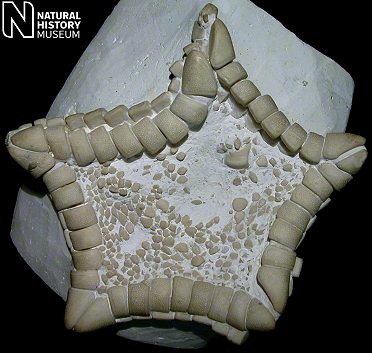 A A |
 B B |
2). Aboral (A) and oral (B) views of two exceptionally preserved specimens; (A) x1.3, Bromley, Kent, BMNH (British Museum (Natural History) London) 46796; (B) x1.6, BMNH 46795. Images © 2005 The Natural History Museum, by kind permission.
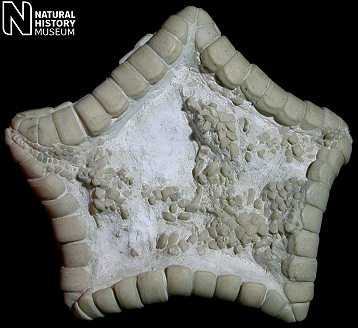 A A |
 B B |
3). Oral (A) and aboral (B) views of a well preserved specimen; x1.4, Bromley, Kent, BMNH (British Museum (Natural History) London) 46765. Images © 2005 The Natural History Museum, by kind permission.

4). Lateral (side) view of a well preserved specimen; note the gently upturned arms tips and the enlarged ultimate superomarginal with several corresponding inferomarginal ossicles (x2.8, Bromley, Kent, BMNH (British Museum (Natural History) London) 46796). Image © 2005 The Natural History Museum, by kind permission. (Distinguish Metopaster from Crateraster) (Compare Metopaster and Recurvaster).
 A A |
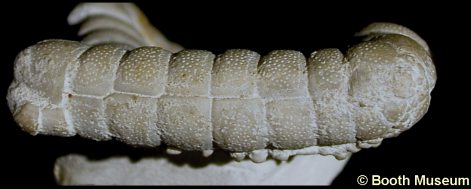 B B |
5). Lateral (side) views; (A) A small specimen with distinctly swollen arm tips, a tendency seen in many Chalk asteroids (e.g. compare Manfredaster) and probably represents an evolutionary response to predation focussed on arm-tips (x2.2, White Chalk, 'Middle Chalk' (Turonian), 'Lewes', Willett collection, Booth Museum, BMB 007822, by kind permission of John Cooper); (B) a larger individual, with an even, almost rectangular profile (x2, White Chalk, 'Lewes', Willett collection, Booth Museum, BMB 007826, by kind permission of John Cooper)
6). (A) Detail of the aboral surface showing the madreporite (x10.3, Bromley, Kent, BMNH (British Museum (Natural History) London) 46796). (B) Oral surface of a small and beautifully preserved individual, (x2, White Chalk, 'Middle Chalk' (Turonian), 'Lewes', Willett collection, Booth Museum, BMB 007822, by kind permission of John Cooper). Image A © 2005 The Natural History Museum, by kind permission.
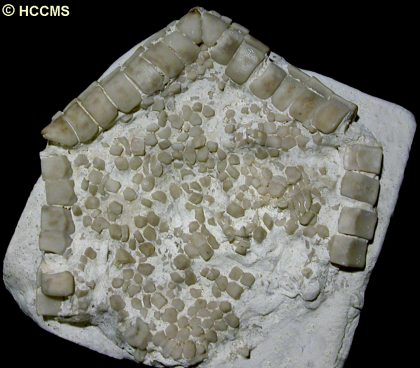 A A |
 B B |
7). (A) Aboral surface of a very large and mature individual (x1.3); (B) Oral view of a moderatley large and very well preserved individual (x1.4); (both Hampshire?, White Chalk, HCCMS (Hampshire County Council Museum's Service) collection, stored at Gosport Museum, (A) G.1981.193, (B) G.1983.365, by kind permission of Dave Kemp, HCCMS).
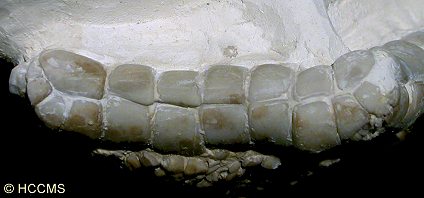
8). Side view of a specimen for which, curiously, the ultimate superomarginals are markedly different sizes (x2.3, Hampshire?, White Chalk, HCCMS (Hampshire County Council Museum's Service) collection, stored at Gosport Museum, G.1983.365, by kind permission of Dave Kemp, HCCMS).
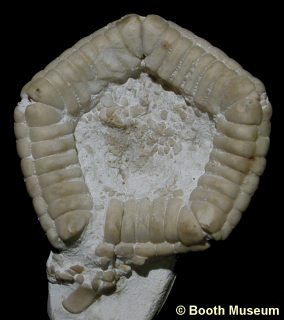 A A |
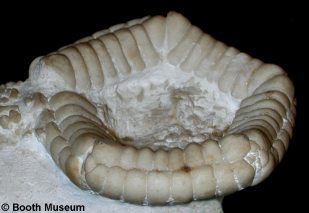 B B |
9). A small and compact variety of Metopaster, originally referred to as Mitraster (x2.5, White Chalk, 'Brighton', Willett collection, Booth Museum, BMB 007820, by kind permission of John Cooper); (A) Aboral view (B) Lateral view.
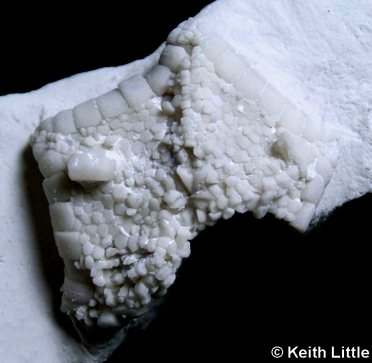 A A |
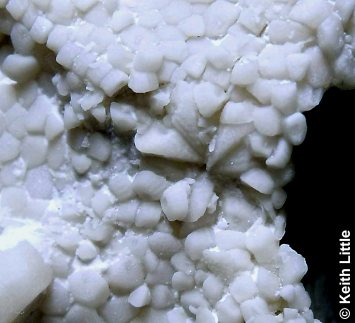 B B |
10). Oral views of a near-complete example displaying excellent articulation (Seaford Chalk, Thanet Coast, Kent, Keith Little Collection, by kind permission): (A) General view (x2.7); (B) Detail of jaw plates (x6.5). Images © 2011 Keith Little.
 A A |
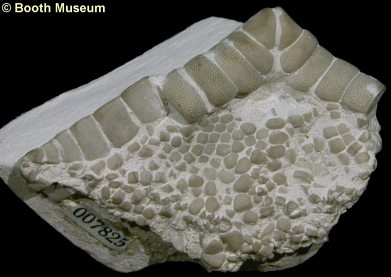 B B |
11). Aboral views of partial specimens (both x2.1, White Chalk, 'Lewes', Willett collection, Booth Museum, (A) BMB 007826, (B) BMB 007825, by kind permission of John Cooper).
 A A |
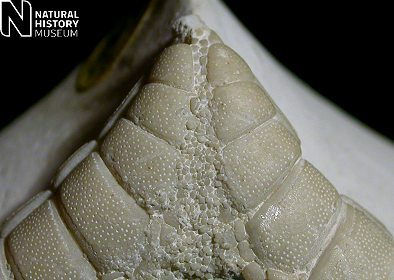 B
B |
12). Oral views of arm tips, notice that the oral ossicles exposed in (A) are obscured beneath a granular outer coat of finer ossicles in (B); (A) x4, White Chalk, 'Middle Chalk' (Turonian), 'Lewes', Willett collection, Booth Museum, BMB 007822, by kind permission of John Cooper; (B) x5.1, BMNH (British Museum (Natural History) London) 46795. Image A © 2005 The Natural History Museum, by kind permission.
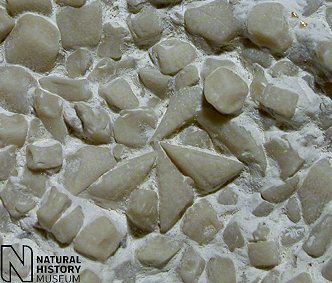 A
A |
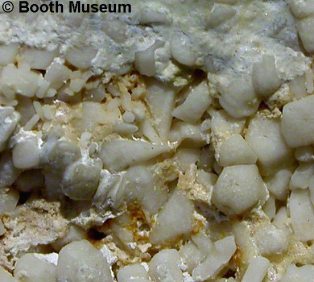 B
B |
13). Details of well preserved oral surfaces, retaining the mouth angle plates; (A) x5.4, Bromley, Kent, BMNH (British Museum (Natural History) London) 40177; (B) x6.0, White Chalk, 'Middle Chalk' (Turonian), 'Lewes', Willett collection, Booth Museum, BMB 007822, by kind permission of John Cooper. Image A © 2005 The Natural History Museum, by kind permission.
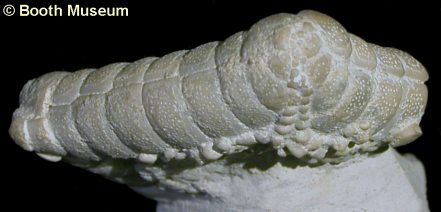 A A |
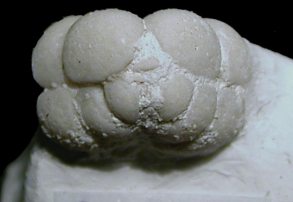 B B |
14). Arm-tips viewed end-on; (A) x2, White Chalk, 'Lewes', Willett collection, Booth Museum, BMB 007826, by kind permission of John Cooper; (B) x7, Seaford Chalk, near Dumpton Gap, Ramsgate, Kent, Randell Collection, RR1539.
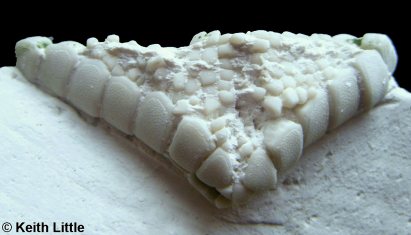 A A |
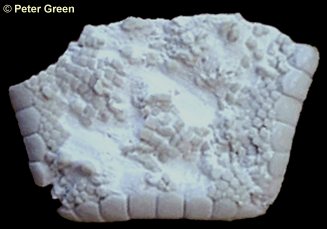 B B |
15). Recent discoveries by collectors in the Kent area: (A) x1.8, Seaford Chalk, Birchington, near Margate, Kent, Keith Little Collection, by kind permission; (B) x1.4, Seaford Chalk, Kingsgate, Thanet, Kent, Peter Green Collection, by kind permission.
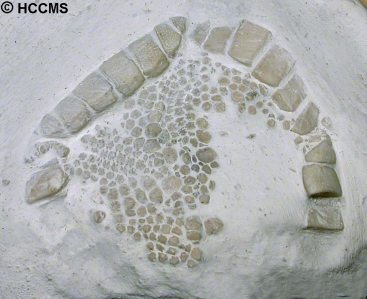 A A |
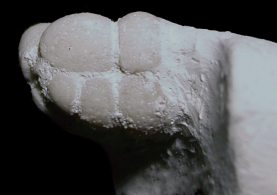 B B |
16). (A) Perfectly articulated but incomplete and unprepared individual (x1.7, Hampshire?, White Chalk, HCCMS (Hampshire County Council Museum's Service) collection, stored at Gosport Museum, G.1983.259, by kind permission of Dave Kemp, HCCMS). (B) Lateral view of an isolated arm tip (x7, Seaford Chalk, near Dumpton Gap, Ramsgate, Kent, Randell Collection, RR1539).